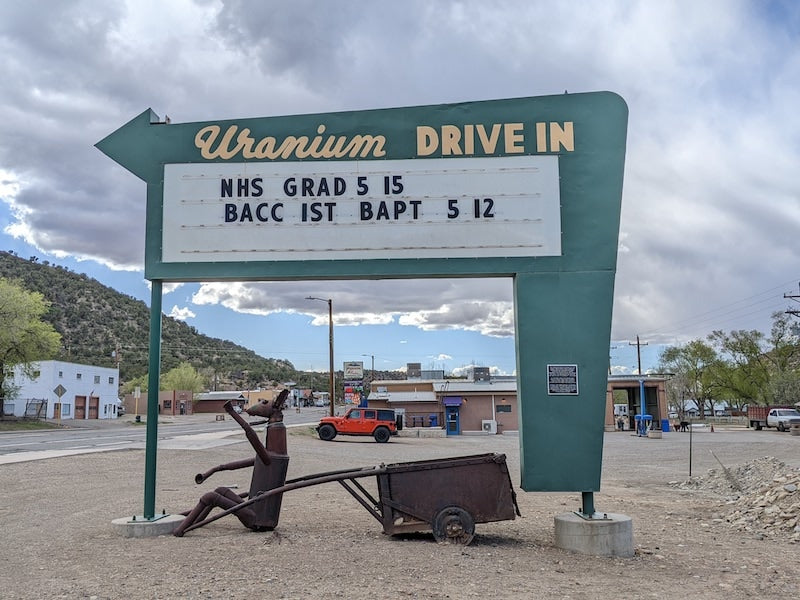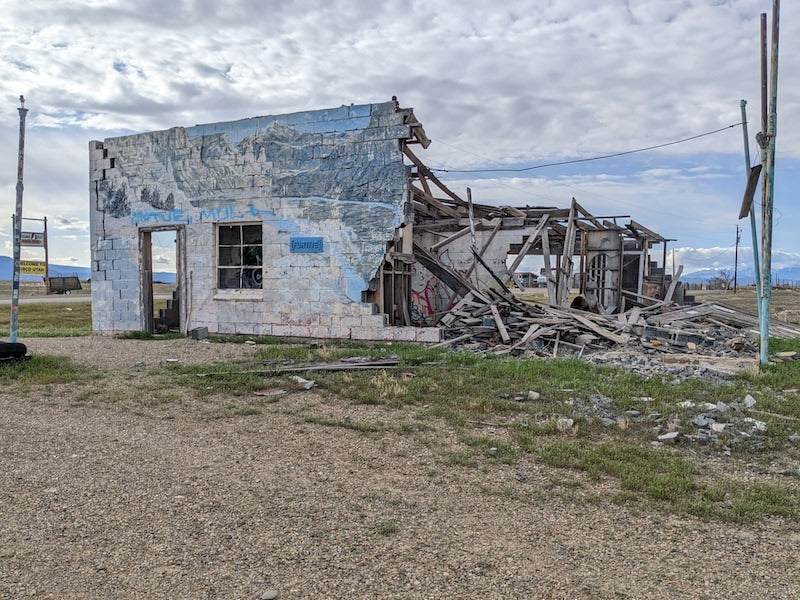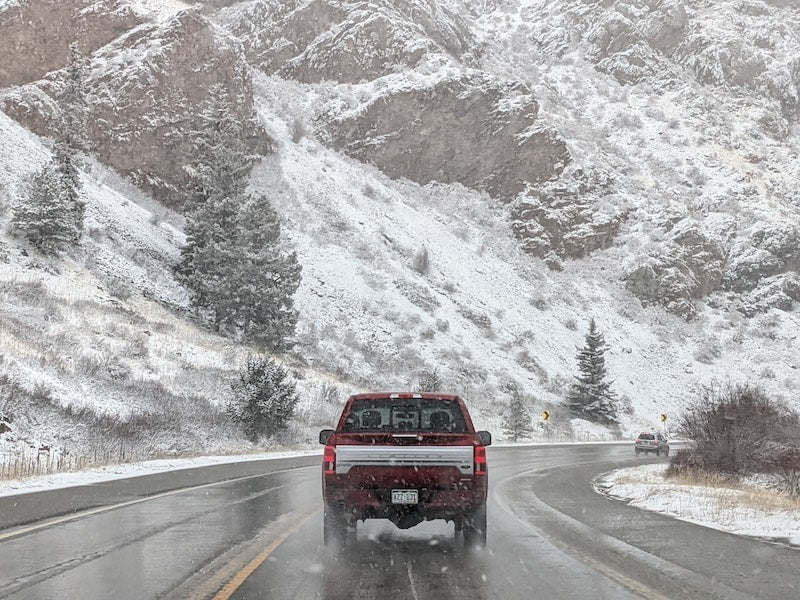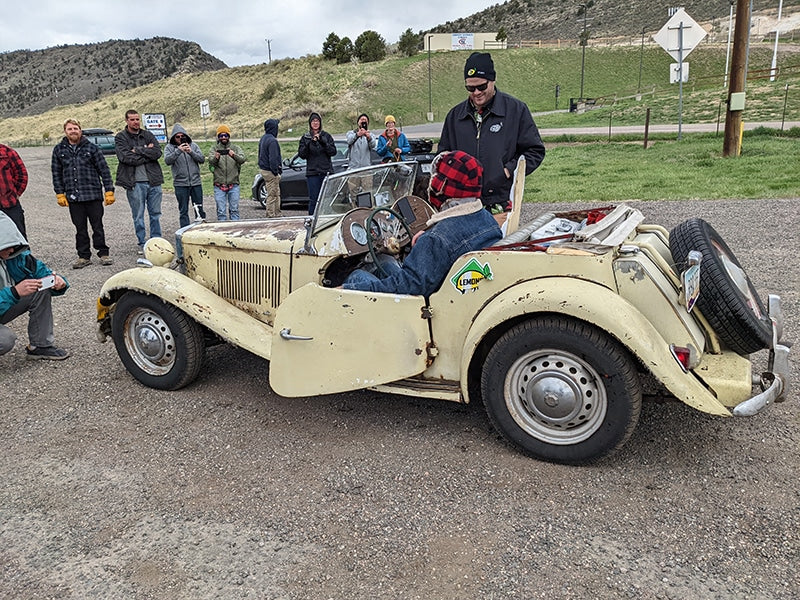In the first half of this travelogue of the 2022 Rocky Mountain Breakdown Lemons Rally (see my article in Issue 163), we passed through Colorado and New Mexico, and arrived in Flagstaff.
Most of us, anyway. A couple of cars were missing in action. The 1953 MG TD was still puttering along without issue, but the truck pulling the horse trailer (which was doing a Kentucky Derby theme) had failed early on, and dropped out. The 1978 Trans Am running the Smokey and The Bandit theme had also quit – they had encountered engine-cooling and carburetion problems, but they did show up at the finish line location in a newer Trans Am they had bought. The rest of us crossed paths several times, and the Lemons staffers skipped many of the checkpoints to arrive early at other checkpoints to get photos of the participants.
Rally Day 3: Eat, Drink and Be Merry, for Tomorrow You May Be in Utah
When we had arrived in Flagstaff, the weather had turned a bit chilly and cloudy, yet the next morning brought us clear skies and some frost. One issue we had to contend with was the Tunnel Fire just north of Flagstaff. We were headed towards Moab, Utah, and US 89 was closed off due to the fire. There were a few alternate routes available. One of them would pass through either the Hopi Reservation or Navajo Nation lands, and we were encouraged not to enter the latter. Another route would have taken us back towards the Arizona border to pick up US 191 before heading north.
That left us with the rally’s official and recommended detour – US 180 to Arizona state road 64 (AZ 64), which heads north and then turns east to rejoin US 89. Anyone who knows the area, as I do, will realize that this was the “$35 Detour” through Grand Canyon National Park. Duck Rock (on the far left) was right where I left it a few years ago.

Duck Rock, Grand Canyon National Park.
US 89 would lead us to US 160, leading us to our checkpoint alongside a coal conveyor, one end of which is pictured below. The conveyor starts 17 miles away at the Kayenta Mine, a former coal mining facility. The conveyor carried up to 240 railcars of coal daily from the mine to the pictured coal silo over the terrain, providing the Navajo Generating Station with coal.

Kayenta Mine.
At Kayenta, we turned onto US 163 North. This let us right into Utah and the heart of Monument Valley, one of a long list of locations in Utah which I have not yet visited. One of our checkpoints was to find Mexican Hat Rock, followed by an iconic photography location that was also used in the scene of a major motion picture. “Run, Forrest, run!”

Monument Valley, Utah.
Loyds Lake (or Lloyd’s Lake, depending on who spells it), a reservoir and small recreational lake, was a checkpoint in Monticello, Utah, just before we had to turn back east on US 491 into Colorado.

Loyd’s Lake, Utah.
Returning to Colorado and locating the Dove Creek Superette checkpoint, we had to also find the Uranium Drive-In, located in Naturita, Colorado. This checkpoint was one of those again requiring some research. The original drive-in sign was in decay and was removed and restored, but unable to be reinstalled at its original location due to zoning laws. Instead, the restored sign was reassembled at Blondie’s Drive-In & Café, a diner in Naturita.

Uranium Drive-In, Naturita, Colorado.
The location of the drive-in movie itself was in Nucla, Colorado, another small town just a couple of miles to the north, and from what I could tell from some research, this is about as close as I could come to the location. The two structures on the right side of the photo might have been part of the entrance to the drive-in.

Near the Uranium Drive-In, Nucla, Colorado.
I skipped the “Find It” mystery location of the day (“You visited the Trinity Site yesterday. Find the bridge leading to the mining town-turned-Superfund site that made the Trinity Site possible.”) since the coordinates I had saved were way off the map (despite it actually being nearby), and I’d had enough driving for the day. This was the Uravan Bridge, which crosses the San Miguel River near Atkinson Creek.
The last stops of the third day were Wilson Arch (visible from US 191) and “Hole N”The Rock,” which is a house built into the side of a large outcropping of stone. That late in the day, the attraction was closed, so it was too late to tell if it was a genuine article or just a kitschy tourist trap.

Hole N”the Rock.
Once in Moab, I grabbed dinner, visited a few favorite shops, plotted my route for the next day, and got some rest.
Rally Day 4: The Long Road Home
The fourth and final day would take us from Moab back to Colorado, namely the Bandimere Speedway in Morrison, Colorado at 6:00 pm for the finish line. I had a hunch that we would take Utah state road 128 (UT 128) and sure enough, one of our checkpoints was midway through the drive back to I 70: the Dewey Bridge.
The Dewey Bridge was one of only three bridges in the state of Utah to cross the Colorado River. When it was built circa 1916, it was the longest suspension bridge in Utah. In 1988, a modern bridge was built to replace it, and the old bridge was restored in 2000 as part of the pedestrian and cyclist bridge for the Kokopelli Trail. In 2008, a young boy playing with matches in a nearby campground accidentally started a brush fire that destroyed the bridge’s wooden deck and rails. The state left the ruins of the bridge intact as a reminder to others about the danger of fire in arid parts of the desert.

Dewey Bridge, Utah.
Another checkpoint along UT 128 took us through the ghost town of Cisco. As many times as I’ve driven through Cisco, I never knew that the corner by the gas station was used for the final scene in the 1971 film Vanishing Point. Some of the rally participants took part in some shenanigans while there.

Shenanigans in Cisco, Utah!
This was the Shell station in the film:

The abandoned Shell station.
While Cisco is considered a ghost town, one business opens during the warmer months – the Buzzard’s Belly General Store, located in what used to be the Cisco Landing Store.
After passing through Fruita, Colorado to find a headless chicken statue, I stopped in Grand Junction at Mesa Mall to collect points for a Lemons Rally Feat of Dumbness. “Take your rally car X-TREME MALLCRAWLING! Whatever that means to you.” From there, I continued to a state park in Cimarron Canyon, in which restored D&RGW locomotive #278 was on display.

Denver & Rio Grande Western locomotive #278.
Further along, our next checkpoint sent us over the Continental Divide via Monarch Pass.

Monarch Pass.
It was a bit snowy…

Driving through Colorado.
The snow continued throughout the rest of the day. We had two final checkpoints to visit, one including a giant hot dog at the Coney Island Boardwalk in Bailey, Colorado (which was founded in 1966 on West Colfax Ave. in Denver, then moved to Aspen Park before being relocated to its present location in Bailey):

Coney Island Boardwalk, Bailey, Colorado.
The giant hot dog was then followed by a very small checkpoint: Tiny Town & Railroad in Morrison, Colorado, an amusement park.

Tiny Town and Railroad, Morrison, Colorado.
Not wanting to cut it too close, I skipped the day’s Find It. “Yugo to this dude’s ranch, but he doesn’t live there anymore.” The Yugo, an ill-fated car built in Yugoslavia, was introduced to the US market by Malcolm Bricklin. He owned a 4,600-acre ranch about 20 miles southeast of Meeker, Colorado, along the White River. It would have added over four hours of driving time if trying to visit all of the checkpoints or would have added an hour and 40 minutes if the three southern checkpoints were skipped. This is an example of how we could choose to skip some checkpoints in favor of others.
Our finish line was officially at 6:00 pm at Bandimere Speedway, where we would hold the impromptu awards ceremony. Although, with the raceway closed, we assembled in the gravel parking lot outside the grounds. We filtered in from about 5:00 pm onward, most of us still carrying snow and ice from the drive through the mountains, and many still sporting bits and pieces of tumbleweeds from Friday’s crossing of New Mexico and Arizona.
Everyone noticed the MG TD had not yet arrived. But at 5:59 pm, guess who was puttering down the road to the parking lot entrance?
It was a foregone conclusion that Jim and his MG had won the top points finish in the rally. Considering the conditions he drove in (the fierce winds and projectile tumbleweeds through New Mexico and Arizona, and the snow over Monarch Pass and beyond, all without a convertible top), all of us were not only relieved that he arrived intact (if somewhat frozen!), we also acknowledged that he had beaten the odds of driving a nearly 70-year-old car, not known for its reliability, over thousands of miles through varying elevations without incident.

The winner!
The final words of the rally master before I left? “Bring a sh*ttier car next time!”
One Final Observation
During the second and third days of the rally, the two longest of the event, I made an effort to hit all of the checkpoints. But by the end of the third day, I’d grown weary of trying to find everything and headed to Moab, only stopping at checkpoints directly along the route. On that third day, our detour through the Grand Canyon cost us over two hours (an hour and 50 minutes extra of straight driving time, not including stops), and we lost another hour due to the time change, Arizona being an hour behind the rest of the Mountain time zone.
The rally planners say it is up to us to choose our checkpoints — none are required, and not all can be reached in a single day. Likewise, if we can’t make it to the recommended town or city at night, no points are gained or lost for staying elsewhere. On the final rally day, I arrived at the checkpoint in Cisco to find several other cars, and the shenanigans that followed. Had I been intent on leaving before dawn and hitting all the checkpoints and challenges, I would have missed out. The delay in sticking around Cisco meant that I caught up with other rally participants at the checkpoints that followed.
Despite this being a competition, I find that taking a slightly more relaxed approach is more fun, as you get a lot more chances to interact with fellow rally participants. Traveling in groups is also recommended. Going for maximum points can turn the rally into a solitary experience, where you feel as though you are making stops for the singular purpose of collecting points.
Would I Do This Again?
The next Lemons Rally event is in July: the Rust Belt Ramble. This event travels from Detroit to Dayton, Pittsburgh, and Buffalo. I already have ideas for the theme, and only have to choose which of my driveway hoopties I will take.
As for the concept of the rally, it’s cleverly conceived. Its intention of doing a send-up of all the stuffy, high-priced road rallies works to its advantage since it is a rally anyone can participate in, no matter what they drive. Also, it’s not only about having fun with cheap and/or old cars and costumes. The rally planner for the Rocky Mountain Breakdown chose some out-of-the-way locations and attractions, taking me to parts of the “Four Corners” states I had never seen before, and learning about attractions and landmarks I had never encountered.
A Lemons Rally isn’t just about winning, it’s also about the experience – seeing new parts of the country, learning about new landmarks, making new friends, and sharing thoughts and ideas along the way. It’s also fun to do something with a car that doesn’t involve commuting, fighting traffic jams, or changing oil.
I will be doing more Lemons rallies in the future, as scheduling and funds permit.
More Lemons Rally Shenanigans
All of the checkpoints were posted (for point tallying) to Instagram using the hashtags #LemonsRally and #RockyMtnBreakdown, along with the hashtag of the checkpoint. The @lemonsrally Instagram account also features highlights of the rally.
All images courtesy of the author.













0 comments